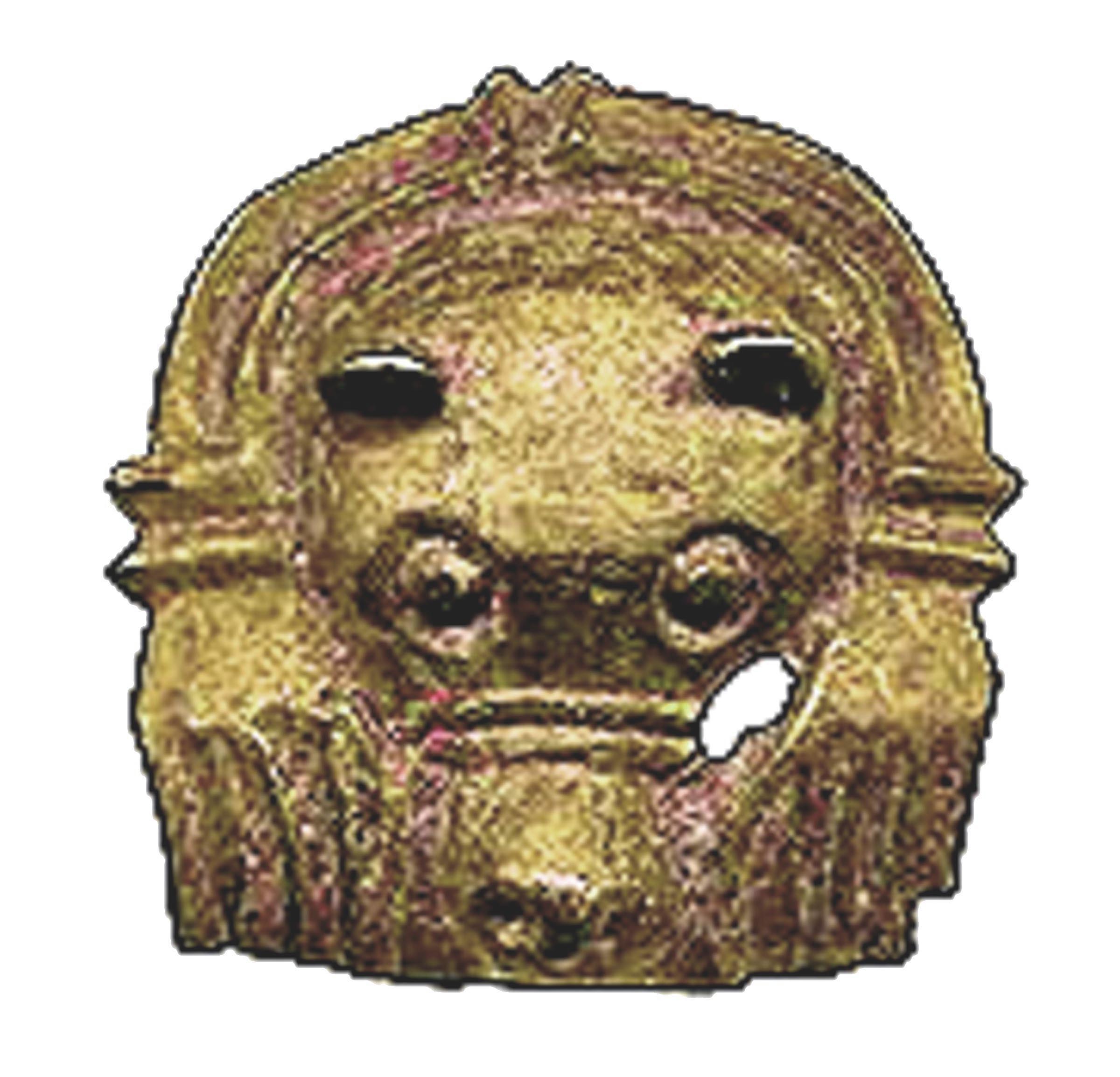

Bears and Humans
AN OLD RELATIONSHIP
Humankind's relationship with bears is deeply rooted in the remote past. At the beginning of the twentieth century, misinterpretation of archaeological findings had led to imagining a Neanderthal “cult” venerating the cave bear (Ursus spelaeus). Enough has been learned since then to discount the idea of such a “cult”. But the difficulties of interpreting anomalous data, especially as ritual behavior, are real, even in examples that seem obvious. For example, something as dramatic as a solitary cave bear skull deposited on top of a block pedestal in Chauvet Cave was explained by one scholar as possible child's play1. In Europe, both cave bears (Ursus spelaeus) and brown bears (Ursus arctos) were hunted and butchered 25-40000 years ago2, while the removal of bear claws and canine teeth, as well as the decoration of bear bones with red ochre3 indicates they had some symbolic value. In Siberia, the inclusion of bear penis bones, along with bear claws, in some graves near Baikal, suggest that by 8000 BC, bears had already become potent fertility symbols4. Carved bear figurines from around the same time have been found at Mal'ta and Buret5 in Eurasia, and later some North American analogs appear6.

It is reasonable to expect that some form of bear ceremonialism was brought to North America with the first people to enter the western hemisphere7. Numerous sites indicating the ritual disposition of bear remains across eastern and central North America have also been documented. Today, there is renewed interest in bear ceremonialism in North American archaeology8. The archaeological record of human-bear relationships, while fragmentary and shadowed by important methodological questions, is geographically extensive and historically deep, and clearly invites further investigation. More archaeological data from both Eurasia and North America is needed to close the gap between deep prehistory and recent ethnography and archaeology.
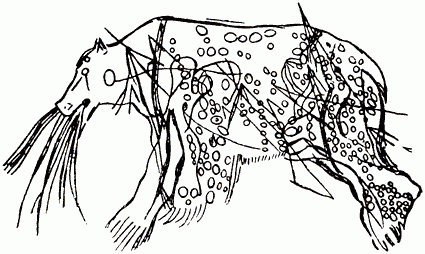
OTHER-THAN-HUMAN PERSONS
Since the classical period, European civilization considered human beings to be exceptional, not only different from but superior to animals and other beings. Indigenous peoples, for the most part, thought of humans as one type of person; other beings might be other-than-human persons. Like human persons, other-than-human persons were understood to have social relations, communication, interests, motivations, memories and histories. Such an understanding is derived from a tradition of observing interactions that shapes both observer and observed in what has been called a "relational ontology."9 This understanding is often reflected in Personal Narratives, like those below, and in indigenous origin stories. Such a worldview rejects “human exceptionalism,” in which Man stands apart from and above the Nature he studies and exploits. This has important consequences for understanding that not only humans but bears and other-than–human persons have both subjectivity and agency.
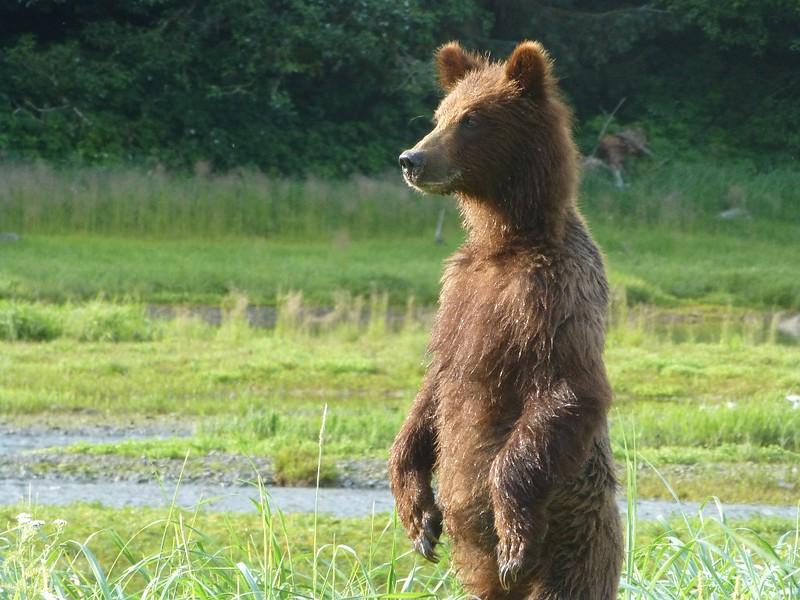
Although bears are frequently reckoned locally as the principal other-than-human persons, bears as other-than-human persons and the agencies attributed to them remain poorly understood. As an example, bears are widely believed to understand human speech, because human persons are physical kin to bears, due to some remote intercourse or transformation in the past. Many circumpolar peoples have stories of the bear’s origin as an other-than-human person, stories which also describe elements of the bear’s character and the bear’s relations to human persons. As Juha Janhunen argued, “The complexities of the Bear Cult could hardly have reached their elaboration without supporting conceptual constructions.”10 Some of the stories involve a she- bear as mother of a group of people11, others a male bear as the lover of a human woman.12
In the carving by Haida artist Charles Edenshaw, the Bear Mother’s two children are shown with her, one in human form, the other in the form of a bear cub. One result of such beliefs is that bears are often addressed in kinship terms, such as "Grandfather" or "Brother." This can easily be misinterpreted as simply respectful address, when in fact, kinship terms almost always imply a host of mutual obligations. Moreover, if humans and bears are kin, humans are implicated in and obligated to all those relationships which bind them to the bear in kinship. In such Origin Stories, the partners of the bear or their offspring are often instructed in the proper way to deal with bears. Explore these stories here.
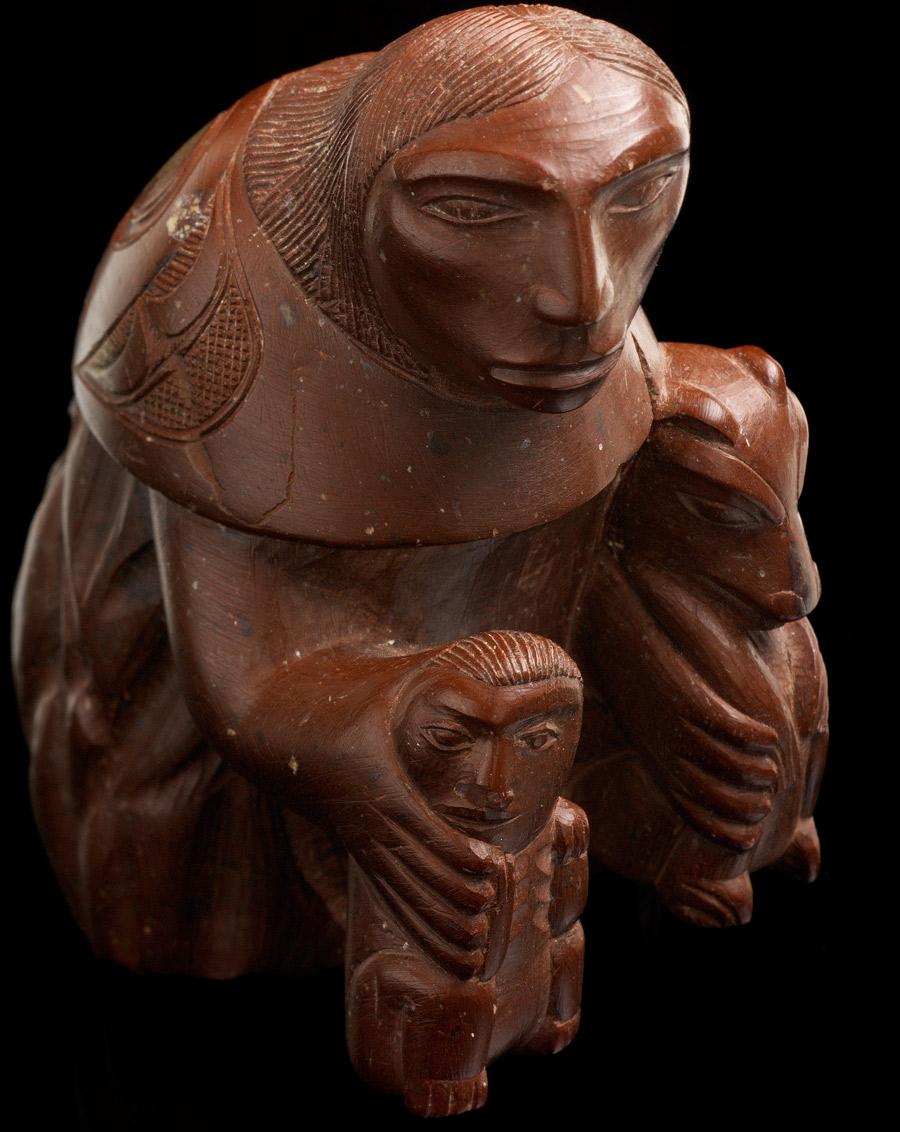
Some formally educated, urban and suburban Euroamericans also appear to attribute not only personhood but individual character to bears13, despite participating in damaging the world they share. Nevertheless, the urgent concern for us all is to understand how indigenous relational ontologies continue to be eroded by acculturative forces, such as Western education and religion, and by commodifying practices, such as commercial hunting or land use policies. The erosion of such indigenous knowledge creates the possibility for potentially catastrophic misunderstandings in those matters of law, medicine, and politics that depend upon socially-constructed understandings of body, identity, and personhood.14
CULTURAL KEYSTONE SPECIES
Cultural Keystone Species have been defined variously as "species whose existence and symbolic value are essential to the stability of a cultural group over time"15, or more precisely, "the culturally salient species that shape in a major way the cultural identity of a people, as reflected in the fundamental roles these species have in diet, materials, medicine, and/or spiritual practices should be."16 Bears are so important to the cultural identity of some groups that they have taken steps to ban bear hunting on their territories. Others recognize the cultural importance of bears through claims of ancestral kinship or by honoring them in ceremonies. Garibaldi and Turner suggests that one might identify a cultural keystone species -- whether plant, fish, bird or animal -- by its prominence in various roles it plays in a community, though these may vary among smaller groups within the community, such as clans, or with the seasons. They suggest the relative importance of the species may be evaluated by addressing six criteria:
- Intensity, type and multiplicity of use
- Naming and terminology in a language, including use as seasonal or phenological indicators, names of months or seasons, place names
- Role in narratives, ceremonies, or symbolism
- Persistence and memory of use in relationship to cultural change
- Level of its unique position in culture
- The extent to which it provides opportunities for resource acquisition from beyond the territory
![“Piikani [Blackfeet] Family in front of Tipi with Bear Design, Cardston, Alberta, 1927.” Photographer: James Willard Schultz](/sites/default/files/styles/max_1300x1300/public/2020-06/Photo%205.%20%20blackfeet%20bear%20tipi.jpg?itok=LJqIOuf1)
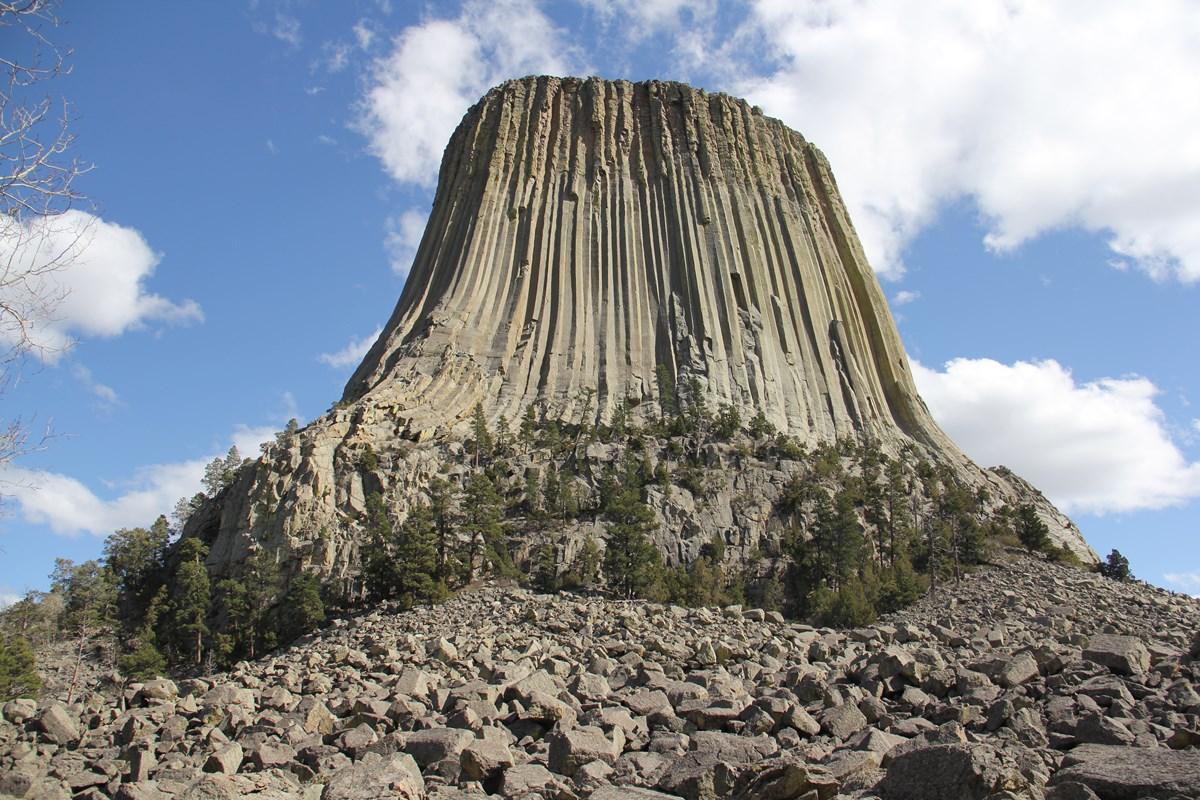
Historically, the world of indigenous peoples was everywhere marked by the presence of bears: on clothing, tipis, shields, in clan crests and personal names, even in the landscape. Devils Tower, the remnant of an ancient volcano rising hundreds of meters above the surrounding land, is only one instance of a landscape feature that has cultural significance for many Native American peoples because Bear left his mark on face of the world.17 Although a number of older studies highlighted the cultural significance of bears to particular peoples, little is understood about the ways in which bears, as a Cultural Keystone Species, presently function among various northern peoples as a "key symbol...useful for sorting out categories of conceptual experience” or how bear ceremonies serve as guides for “certain culturally effective courses of action.”18 Can bear ceremonialism adapt to a rapidly changing social and physical environment so as to continue to provide cultural guidance on sharing the world with bear-persons?
PERSONAL NARRATIVES
Personal narratives offer individual descriptions of important moments in a person’s life. Everyone tells such stories. Those about especially memorable events, such as encounters with bears, are often told and retold. And because we are social beings, our sense of what is important and why it is so are shaped by the values and beliefs of our community. These narratives below were recorded from Eastern Khanty individuals. Their community and their bear ceremony is described here in this website. Often the actions and voices in these narratives reveal important beliefs about the nature of bears as other-than-human persons. Such beliefs help us understand both the helpful and the unhelpful ways in which bears and humans share the world. Khanty, for instance, believe that when the high god, Torum, set the first bear upon the earth, he was charged not to attack humans or to be destructive and wasteful. A bear who violated those conditions could be killed without an ceremony.
Yugan Khanty
Recorded from PVK, at his settlement on the Bolshoi Yugan River, Siberia, Russia, 1995.
1) Since for us [Khanty], according to our custom, the bear is considered to be the most important one, so, whenever you are at home, even anywhere else and you speak about the Bear, he would hear that in any case. However you name him, or however you insult him, he will hear you. Kind words he will hear, and curses he will hear. Thus, one time, this man took it upon himself to insult a bear in order to provoke a meeting with him to fight him. A long time passed. Then in summer, because they especially hunt big animals in summer—the reindeer, moose, bear—he and his partner went together by water in dugouts, and the other man didn’t know that his partner had insulted a bear. He had cursed him in order to provoke a confrontation with him in order to see who would win. And he said once to his partner, “While we are going around here, spending nights here, if anything happens, you should yell out with all your might.” And they lay down to sleep, to spend the night, near the water, by the shore. And this guy, the one who cursed the bear, he lay down farther away from the water, and his partner was closer to the water; that was how they always slept. That’s how they lay down at night.
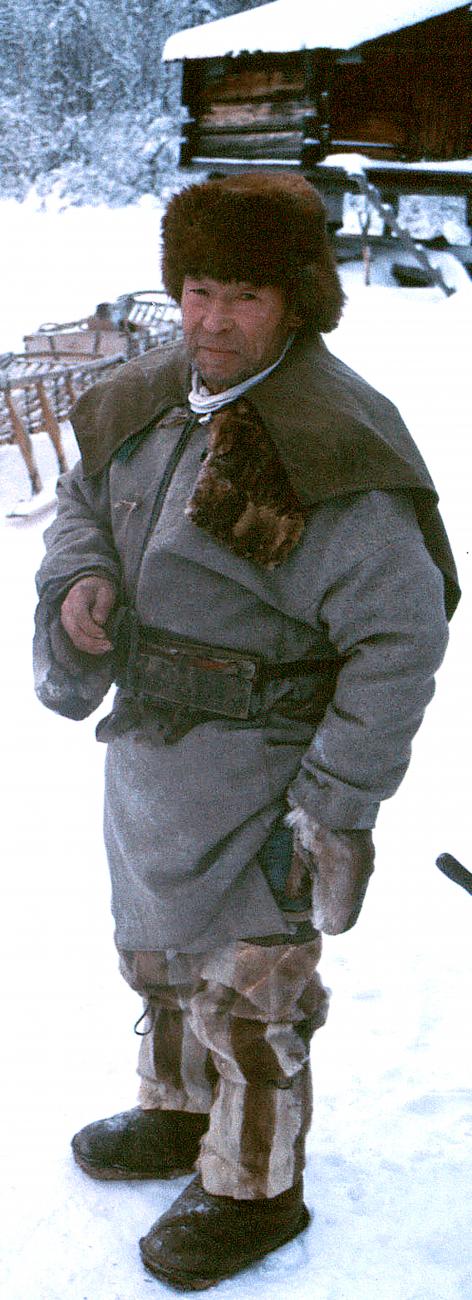
One time this partner hears water splashing on him. He opens his eyes. A bear is cupping water with his paws intending to pour the water on the guy who cursed him, to wake him. The bear, see, according to our custom, doesn’t touch a sleeping person. Well, so the other guy started to yell. The bear ran a little ways off. They had kept everything ready in their dugout canoes. In both dugouts, or maybe just one of them. The dugouts were always ready for them. There are arrows, bows, there in the dugouts. Everything at the ready. They thus jumped into the dugouts and pushed off. And the bear went off a ways. He is standing there. Probably he again wants to approach them. They shot at him with their bows and arrows. Thus they killed him.
2) This is a story I heard from some people: Someone caught a bear cub here and brought him up. In the winter he would go hunting and take this bear. He went to the deep forest with a small sled, and the bear would pull this thing. And wherever they stopped to spend the night, or to live, the bear would bring wood. At that time, people did not live in tents but simply outdoors, beside a fire. They’d stretch out something on the ground and live like that. On one side was the fire, and in order to stop the wind coming from behind, they would stretch out some material. That’s how they lived.
Then once a shatun [a rogue bear who doesn’t hibernate, or who wakes up from hibernation early and hungry] came to their place. At first, they didn’t notice it, but the bear, sitting near the fire, tensed up, planted his legs into the ground, and his hair stood up. He (the hunter) asked,” Something wrong with you? You feel bad?” The bear turned to him and became calm. His hair laid back down, and he rubbed up against the hunter. Then he sits again on the other side. Sometime in the evening, or perhaps at night, his bear jumped up, and that second bear was there, and the two fought. It seems the rogue bear had come to them. He seizes his spear, runs over there. Here they are fighting. He called his bear, Dolly. “Dolly,” he says, are you on top or beneath him?” He knows that one is underneath and one on top. They both collapsed, and this one, his Dolly, moaned from underneath. Then he took the one who was on top on his spear, and killed him. Who knows, how long or short, [it took him to die]. Probably not very long.
His bear for some reason also became sad. They understand each other somehow, some way. And the master somehow understood how he felt: he should release him, it [the bear] should go away. “If you need to, leave.” It’s not permitted for them to live together for a long time. For some time, 3 or 4 years, they had lived together. He was already grown up and become a big one. And the master put a ring on his bear’s smallest claw.
The next summer, or however long time it was, I don’t know, they meet again in the summer. He met the bear. It seemed that he was waiting for his master, and for some reason showed his paw. They came to each other. He had this ring. His hair had grown like that. The master filed off the ring, and they parted again. Perhaps he put on another ring on him, a little bit bigger one. And then this bear was killed on Malyi Yugan River
Trom-Agan Khanty
Recorded from SVK, in the village of Russkinskiye, Siberia, Russia, 2019.
I don’t touch them [bears]. But when the bear touches me, I touch them. This one bear for three years killed a lot of reindeer. A lot of reindeer. They ate or just killed for nothing. At first it was only one bear, then there were two, and finally there were six bears They came in pairs, two by two, male and female, three different pairs, not six all at once. I also started to run here and there, Come out, show yourself, and they understood, even my mat' (obscenities). I yelled at him so that he should show himself, and not hide. He killed my reindeer.
And two of them showed themselves, the biggest ones. Yes, I laid them down (zavalit'). The first one I shot had been previously injured. [Addressing the bear] "If you were injured [by me], you should have shown me that the blood has already started to run, then I would not be running towards you. If there is blood running, you can leave, but if there is no blood, you should stay where you are." But he stood up, showing himself. I made three shots. The first shot hit a tree and the second the bear, but I let the bear go away. The second bear was standing up and I ran directly towards him, lifted my gun and shot him. In the end, the first bear [the wounded one] turned around and slowly started to go away, and I asked him," Why are you going away? Wait up for me?" and the bear stopped for a bit, he was tired, and then he moved on, and there was a forest there, and I lost him. [Question asked: Should the bear that killed the reindeer have stayed?] Yes, he should have even stood up, and stopped a little, but then he went away. We had then about 60 head, and the bears got 30.
The first time the bears killed so many reindeers, I started to scold them, "You should not just trash them,” I said to them, “you know what I will do to you? You do have a Father. I will talk to your Father [Torum, the High God]. I fetched 7 meters of fabric, and where I found them, I tied the fabric, and then I said to the bears' father, “You should punish your sons and daughters. If they attack my reindeer, they should eat it to the end, and leave just one bone for me.” And now when the bears catch reindeer, they do eat it only until the small bones are left.
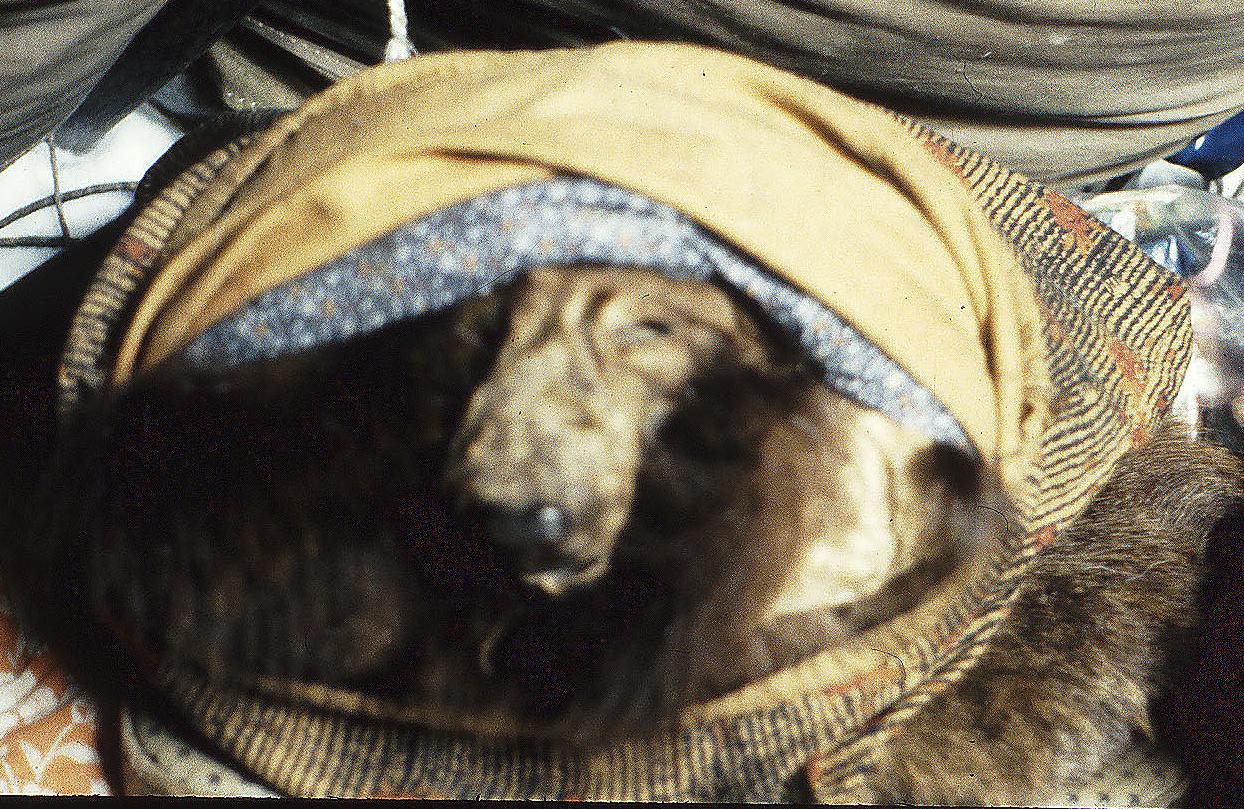
Such bears are really misbehaving. Sometimes there are such bears that simply chase the reindeer. For instance, calves run around and the bear chases them. There are calves on the left and the right, but he just chases the adult reindeer, and we thought it was interested in it, but it just hit the reindeer, it didn't kill the deer, just chased it [as for sport]. But when they themselves [the reindeer herders] went to cut down that deer, the bear stopped chasing it. For some unknown reason, he doesn't catch them, kill them, eat them, but chases them. They killed it. There are such bears who just chase reindeers, don’t catch them. When the herder goes out, the bear hides and one can't find him.
Finally they made a representation of him, [kukla] using a Bear's head with skin and paws wrapped in material. And one can ask questions of it, and it is kept on a shelf. And if you have such a thing, you could ask it, "Why does your brother or sister visit us, chasing the reindeer?" And the answer would be, "There is a guy living in this or that house, and that guy has sent the bear to do this." In order to stop this, one doesn't have to present a gift to the bear's head; it’s enough that I know the culprit's identity.
After the danger has passed, it can stay on the shelf as many years as you want.
1 Bahn, P.G., 2011. "Religion and Ritual in the Upper Palaeolithic", in The Oxford handbook of the archaeology of ritual and religion. Edited by Tim Insoll, pp.344-357. Oxford: Oxford University Press. 352,353
2 Armand, D., 2006. Abri castanet (Dordogne, Grance): an aurignacian site with bear procurement. Bear exploitation in paleolithic time. Επιστημονική Επετηρίδα του Τμήματος Γεωλογίας (ΑΠΘ), 98, pp.263-268.; Münzel, S.C. and Conard, N.J., 2004. Cave bear hunting in the Hohle Fels, a cave site in the Ach Valley, Swabian Jura. Revue de Paléobiologie, 23(2), pp.877-885.
3 Germonpré, M. and Hämäläinen, R., 2007. Fossil bear bones in the Belgian Upper Paleolithic: the possibility of a proto bear-ceremonialism. Arctic Anthropology, 44(2), pp.1-30.
4 Losey, R.J., V. Bazaliiskii, A. Lieverse, A. Waters-Rist, K. Faccia, and A. Weber, 2013. The bear-able likeness of being: ursine remains at the Shamanka II cemetery, Lake Baikal, Siberia. Relational archaeologies: humans, animals, things, pp.65-96.
5 Morozov, A. V. 2010. On the problems of researching small art forms of the Neolithic-eneolithic epochs in Sibiri (on the example of analyzing bear images) [K probleme izucheniya iskusstva malykh form epokhi neolita-eneolita sibiri (na primere analize obraza medvediya)]. Vestnik arkeologii, antropologii i etnografii. 2.13:12-19; Vasil'evskii, R.S. and Okladnikov, A.P., 1990. Images of bears in the Neolithic art of northern Asia. Soviet Anthropology and Archeology 28(4): 81-90.
6 Koerper, H. and Farmer, M., 1987. A bear-shaped crescentic from northern San Diego County, California. Journal of California and Great Basin Anthropology 9: 282-288.
7 Hallowell, A.I. 1926. p. 156. 9 Berres, T.E., Stothers, D.M. and Mather, D., 2004. Bear imagery and ritual in northeast North America: an update and assessment of A. Irving Hallowell's work. Midcontinental Journal of Archaeology 29: 5-42.
8 Berres, T.E., Stothers, D.M. and Mather, D., 2004. Bear imagery and ritual in northeast North America: an update and assessment of A. Irving Hallowell's work. Midcontinental Journal of Archaeology 29: 5-42. Lapham, H. A. and (Editor), G. A. Waselkov, eds., 2020. Bears: Archaeological and Ethnohistorical Perspectives in Native Eastern North America (Florida Museum of Natural History: Ripley P. Bullen Series) Gainesville: University of Florida Press.
9 Willerslev, R., 2007. Soul hunters: hunting, animism, and personhood among the Siberian Yukaghirs. Berkeley: University of California Press.77, 116 ff.; T. Ingold. 2004. A circumpolar night's dream. In Figured worlds: Ontological obstacles in intercultural relations. Edited by J. R. Clammer, S. Poirier and E. Schwimmer, pp. 25-57. Toronto: University of Toronto Press; Hill, E., 2011. Animals as agents: Hunting ritual and relational ontologies in prehistoric Alaska and Chukotka. Cambridge Archaeological Journal 21: 407-426; Clark, D. A., and D. S. Slocombe. 2009. Respect for grizzly bear: an Aboriginal approach for co-existence and resilience. Ecology and Society 14(1): 42. [online] URL: http://www.ecologyandsociety.org/vol14/iss1/art42/
10 Janhunen, J., 2003. Tracing the bear myth in northeast Asia. Acta Slavica Iaponica, (20), pp.1-24.
11 Barbeau, M., 1946. Bear mother. The Journal of American Folklore, 59(231), pp.1-12.
12 Edsman, C.M., 1956. The story of the bear wife in nordic tradition. Ethnos, 21(1-2), pp.36-56.
13 Myers, G. and Russell, A., 2003. Human identity in relation to wild black bears: A natural-social ecology of subjective creatures. In Identity and the natural environment: The psychological significance of nature. Edited by S. Clayton and S. Opotow, pp.67-90. Cambridge, MA.: MIT Press
14 Nadasdy, P., 2003. Hunters and bureaucrats: power, knowledge, and aboriginal-state relations in the southwest Yukon. Vancouver: UBC Press.
15 Cristancho, S. and Vining, J., 2004. Culturally defined keystone species. Human Ecology Review, 11(2). P 155
16 Garibaldi, A. and Turner, N., 2004. Cultural keystone species: implications for ecological conservation and restoration. Ecology and society, 9(3):1. (Available at: http://www.ecologyandsociety.org/vol9/iss3/art1)
17 https://www.nps.gov/deto/learn/historyculture/first-stories.htm
18 Ortner, S.B., 1973. On Key Symbols. American anthropologist, 75(5), pp.1342.

